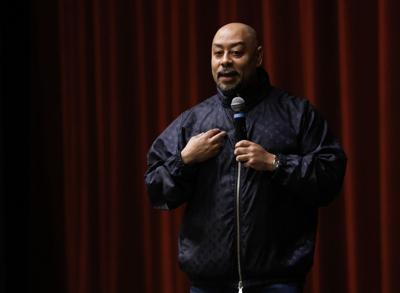As cautionary tales go, Raymond Santana’s is about as unsettling as they get.
As a 14-year-old growing up in New York City in 1989, he and four friends unwittingly stumbled into a situation in Central Park one April night that forever changed their lives.
Though they had nothing to do with it, Santana and his teenage buddies — eventually dubbed the “Central Park Five” by the New York press — were convicted of assaulting and raping a jogger. Railroaded through the justice system because of incorrect assumptions and overly aggressive police interrogations, they all went to prison before the actual perpetrator of the crime — an incarcerated serial rapist — finally admitted his guilt.
But by then Santana had served seven years of hard time and had gone from being a teenager to a man in his late 20s. When he was released in 2002, he’d been socially isolated and living under an unwarranted stigma for more than a decade.
Now middle-aged, Santana shared his story recently with local high school students during an hourlong presentation at Eisenhower High School. He tells the story to others, he explained to teenagers from Ike, Davis and Stanton high schools, because the lessons still apply.
“If you don’t know what happened,” he warned, “it can happen again.”
He’s right, of course. Just ask Evaristo Junior Salas, who spent more than 26 years in prison for a 1995 Sunnyside murder he insists to this day that he didn’t commit. Salas, finally released last year after the stories of several witnesses at his trial unraveled, was 15 when he was tried as an adult and sentenced to 33 years.
Clearly, our system isn’t perfect — and how we improve it isn’t exactly an open-and-shut case.
Police, prosecutors and politicians have been under intense public pressure for years to fight crime, cut the red tape in courtrooms and keep us all safer.
After all, we want our protectors to catch criminals and put them away.
A case like Santana’s is tragic, yet it’s easy to see how a nervous public would eagerly jump to conclusions over circumstantial evidence, especially if it were shored up with confessions — however forced they might have been.
We put a lot of trust, and a lot of stock, in the word of our law enforcement community. If they’re convinced someone’s guilty, most people presume they probably are. But for understandable reasons, we rarely see how the evidence is gathered.
What if the police are wrong? Or worse yet — in a case like Santana’s — what if they aren’t thorough enough, break rules and force unjust outcomes?
We don’t pretend to have the answers, but it’s important to consider stories like Santana’s and heed his warnings about keeping a watchful eye on the justice system and getting involved in solutions.
It’s a system that needs close monitoring and regular fine-tuning.
One current example: A bill currently under consideration in the state House of Representatives would make statements inadmissible in court if police lie or use deceptive tactics to squeeze them out of defendants. That seems reasonable — police of all people shouldn’t lie.
A single bill, naturally, won’t fix everything. And if it passes, it could easily create unexpected ripple effects.
Still, with people’s very lives riding on it, it’s work that must continue.
And as Santana, who’s now a member of the “Exonerated Five,” told the students at Ike, “We have to do it together.”




